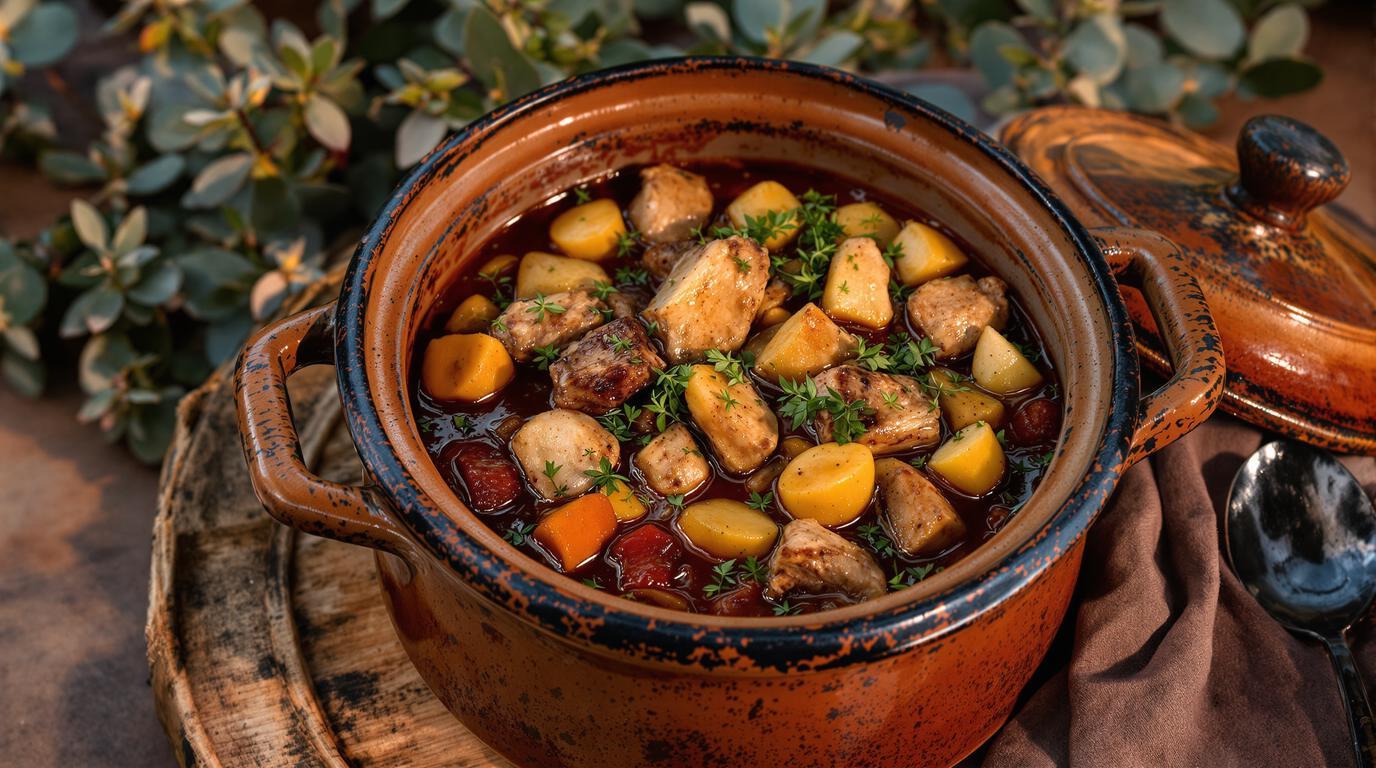The first time I cooked kangaroo meat was during my apprenticeship in Sydney. The head chef—a weathered Australian with hands that told stories of decades in professional kitchens—handed me a dark, lean cut and said, “This isn’t beef, mate. Treat it with respect or it’ll turn to leather.” That lesson stuck with me through 20 years of professional cooking. Kangaroo isn’t just meat; it’s 40,000 years of Indigenous Australian culinary tradition simmered into one pot. The deep ruby-red flesh carries the essence of the Australian outback—wild, untamed, and profoundly sustainable. This slow-cooked stew honors those traditions while making this extraordinary protein accessible to home cooks.
The Story Behind Traditional Kangaroo Stew 📖
Long before European settlement, Aboriginal Australians slow-cooked kangaroo in earth ovens or over open fires, often with native plants and spices. The meat—remarkably lean at less than 2% fat—benefits tremendously from gentle, moisture-rich cooking methods. Today’s version adapts these ancient techniques for the modern kitchen while preserving the meat’s distinctive character. Unlike beef, which forgives many cooking mistakes, kangaroo demands attention to method and timing. The reward? A deeply flavorful stew with unmatched nutritional benefits—nearly twice the protein of beef and three times the iron of chicken or pork.
Essential Ingredients 🧾
The soul of this dish comes from the interplay between gamey kangaroo and earthy root vegetables. You’ll need:
- 1 kg (2.2 lbs) kangaroo meat, trimmed and cubed
- 3 medium onions, roughly chopped
- 6 garlic cloves, minced
- 4 large carrots, chunked
- 4 large potatoes, cubed
- 2 large parsnips, chunked
- 2 bay leaves
- 1 tsp black pepper (or Tasmanian pepperberry if available)
- 250ml (8.5 oz) red wine
- 1L (4.3 cups) beef stock
- 2 tbsp olive oil or animal fat
Chef’s Note: Can’t source kangaroo? While nothing perfectly replicates its unique flavor profile, venison makes the closest substitute. The cooking approach remains identical—slow and gentle with plenty of moisture.
Step-by-Step Instructions 📝
1. Prep your kangaroo by trimming any silverskin or membranes, then cut into 2.5cm (1-inch) cubes. Pat dry with paper towels—moisture is the enemy of proper browning.
2. Heat your oil or fat in a heavy-bottomed Dutch oven until it shimmers. Working in small batches (never crowd the pan!), sear the kangaroo pieces until deeply browned on all sides, about 2 minutes per batch. This step creates the foundation of flavor through the Maillard reaction. Remove and set aside.
3. Reduce heat to medium and add onions to the same pot. Cook until translucent, about 5 minutes, scraping up the flavorful fond from the bottom. Add garlic during the final minute to prevent burning.
4. Add your root vegetables and stir to coat with the fat. The initial vegetable sauté creates depth through caramelization.
5. Return the kangaroo to the pot along with bay leaves and pepper. Pour in the wine, bringing to a simmer while scraping any remaining browned bits.
6. Add stock until meat and vegetables are just covered. Bring to a gentle simmer, then reduce heat to very low, cover tightly, and cook for 2.5-3 hours. The stew is done when the kangaroo yields easily to a fork but still retains some texture.
Chef’s Secret Techniques 🤫
The cardinal rule with kangaroo is: never overcook it. Unlike beef chuck that forgives hours of cooking, kangaroo becomes dry and tough if pushed too far. I check tenderness at the 2-hour mark, then every 20 minutes after.
For deeper dimension, I sometimes add native Australian flavors like lemon myrtle (substitute with 1 tsp lemon zest + 1 tsp thyme) or bush tomatoes. Consider exploring dry rubs with native spices if you’re feeling adventurous.
The stew benefits tremendously from resting overnight—flavors meld and mature in remarkable ways. Like my tonkotsu ramen, patience yields extraordinary results.
Serving & Presentation Tips 🍽️
Serve this stew in rustic earthenware or cast iron to honor its traditional roots. A robust Australian Shiraz makes the perfect companion—the wine’s bold tannins beautifully complement the meat’s unique character. For sides, consider roasted native greens or a simple damper bread to soak up the rich sauce.
This stew aligns wonderfully with globally-inspired dishes like Turkish kebabs or Italian pasta, celebrating how traditional proteins can cross cultural boundaries. For a complete Australian experience, consider grilled vegetables as an accompaniment.
I’ve served this stew throughout my career, from high-end Sydney restaurants to intimate family gatherings, and it always carries the same message: sustainable, traditional ingredients deserve our utmost respect in the kitchen. When you serve this kangaroo stew, you’re not just offering dinner—you’re sharing 40,000 years of Australia’s culinary heritage in a single, magnificent pot.
